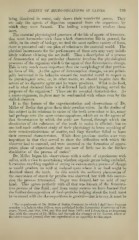Page 749 - My FlipBook
P. 749
AGEXCY OF MICRO-ORGANISMS IN CARTES. 759
being dissolved in water, only shows their wonderfnl power. They
are only the agents of digestion separated from the organisms by
which they were formed. The boiling temperature renders them
inert.
The essential physiological processes of the life of agents of fermenta-
tion must harmonize with those which characterize life in general, for
while, in the study of biology, Ave find the most endless variety of form,
there is presented only one plan of relation to the material world. The
physical instruments for the performance of these acts may vary indefi-
nitely without vitiating the act itself. Thus a description of a process
of fermentation of any particular character involves the physiological
processes of the organism which is the agent of that fermentative change.
This is very much more important than the morpliology of that particu-
lar form of life. As the agent of fermentative changes, we are princi-
pally interested in its behavior toward the material world in respect to
or, in other words, we should inquire into the
its physiological acts ;
nature of its digestive agent and its waste products. What is its food,
and in what chemical form is it delivered back after having served the
purposes of the organism ? These are its essential characteristics. As
a micro-organism, iia form may be confounded with others even by the
skilled observer.
It is this feature of the experimentation and observations of Dr.
Miller of Berlin that gives them their peculiar value. In the studies of
this subject in its relations to caries of the teeth antecedent to his, many
had perliaps seen the same micro-organisms, which act as the agents of
that fermentation by which tlie acids are formed, through which the
dissolution of the substance of the tooth in caries is effected ; but no
one had made sufficient study of their physiology to know anything of
their remolecularizations of matter, and they therefore failed to learn
their essential characteristics. While these previous studies were very
important in that they served to show the difficulties with which the
observer had to contend, and were essential to the formation of appro-
priate plans of experiment, they are now of little use in the further
elucidation of tlie process of caries.^
Dr. Miller began his observations with a series of experiments with
saliva, with a view to ascertaining whether, organic germs being excluded,
it contains anything capable of setting in motion such a process of change
as would produce an acid at isolated spots where it or food might be
detained about the teeth. In this search the ordinary phenomena of
the conversion of starch by ptyalin was observed, but with this conver-
sion the process terminated. Sugar was formed, but no acid of any
kind. This agrees perfectly with all that was known of the fermenta-
tive powers of this fluid ; and from many sources we have learned that
the further decomposition of food-particles lodging about the teeth must
be in accord with the decompositions in general—that is to say, it must be
^ The experiments of Dr. Miller of Berlin, Germany, to which I shall have frequent
occasion to allude in what follows, were published in the Independent Pracliiioner of p^eb-
rnary, March, and May, 1S84. and May and June, 1885; and I deem them so important
that, with the consent of Dr. Miller, and through the courtesy of Dr. Barrett, editor of
the above-named journal, they are reproduced as an appendix to this paper.


